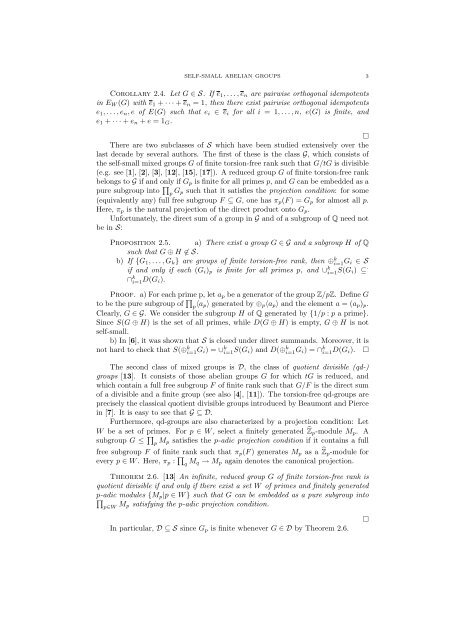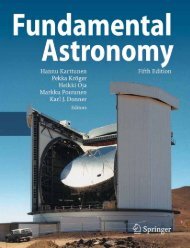Self-small Abelian Groups
Self-small Abelian Groups
Self-small Abelian Groups
You also want an ePaper? Increase the reach of your titles
YUMPU automatically turns print PDFs into web optimized ePapers that Google loves.
SELF-SMALL ABELIAN GROUPS 3<br />
Corollary 2.4. Let G ∈ S. If e1, . . . , en are pairwise orthogonal idempotents<br />
in EW (G) with e1 + · · · + en = 1, then there exist pairwise orthogonal idempotents<br />
e1, . . . , en, e of E(G) such that ei ∈ ei for all i = 1, . . . , n, e(G) is finite, and<br />
e1 + · · · + en + e = 1G.<br />
<br />
There are two subclasses of S which have been studied extensively over the<br />
last decade by several authors. The first of these is the class G, which consists of<br />
the self-<strong>small</strong> mixed groups G of finite torsion-free rank such that G/tG is divisible<br />
(e.g. see [1], [2], [3], [12], [15], [17]). A reduced group G of finite torsion-free rank<br />
belongs to G if and only if Gp is finite for all primes p, and G can be embedded as a<br />
pure subgroup into <br />
p Gp such that it satisfies the projection condition: for some<br />
(equivalently any) full free subgroup F ⊆ G, one has πp(F ) = Gp for almost all p.<br />
Here, πp is the natural projection of the direct product onto Gp.<br />
Unfortunately, the direct sum of a group in G and of a subgroup of Q need not<br />
be in S:<br />
Proposition 2.5. a) There exist a group G ∈ G and a subgroup H of Q<br />
such that G ⊕ H ∈ S.<br />
b) If {G1, . . . , Gk} are groups of finite torsion-free rank, then ⊕ k i=1 Gi ∈ S<br />
if and only if each (Gi)p is finite for all primes p, and ∪ k i=1 S(Gi) ⊆ ·<br />
∩ k i=1 D(Gi).<br />
Proof. a) For each prime p, let ap be a generator of the group Z/pZ. Define G<br />
to be the pure subgroup of <br />
p 〈ap〉 generated by ⊕p〈ap〉 and the element a = (ap)p.<br />
Clearly, G ∈ G. We consider the subgroup H of Q generated by {1/p : p a prime}.<br />
Since S(G ⊕ H) is the set of all primes, while D(G ⊕ H) is empty, G ⊕ H is not<br />
self-<strong>small</strong>.<br />
b) In [6], it was shown that S is closed under direct summands. Moreover, it is<br />
not hard to check that S(⊕k i=1Gi) = ∪k i=1S(Gi) and D(⊕k i=1Gi) = ∩k i=1D(Gi). <br />
The second class of mixed groups is D, the class of quotient divisible (qd-)<br />
groups [13]. It consists of those abelian groups G for which tG is reduced, and<br />
which contain a full free subgroup F of finite rank such that G/F is the direct sum<br />
of a divisible and a finite group (see also [4], [11]). The torsion-free qd-groups are<br />
precisely the classical quotient divisible groups introduced by Beaumont and Pierce<br />
in [7]. It is easy to see that G ⊆ D.<br />
Furthermore, qd-groups are also characterized by a projection condition: Let<br />
W be a set of primes. For p ∈ W , select a finitely generated Zp-module Mp. A<br />
subgroup G ≤ <br />
p Mp satisfies the p-adic projection condition if it contains a full<br />
free subgroup F of finite rank such that πp(F ) generates Mp as a Zp-module for<br />
every p ∈ W . Here, πp : <br />
q Mq → Mp again denotes the canonical projection.<br />
Theorem 2.6. [13] An infinite, reduced group G of finite torsion-free rank is<br />
quotient divisible if and only if there exist a set W of primes and finitely generated<br />
p-adic modules {Mp|p ∈ W } such that G can be embedded as a pure subgroup into<br />
<br />
p∈W Mp satisfying the p-adic projection condition.<br />
In particular, D ⊆ S since Gp is finite whenever G ∈ D by Theorem 2.6.
















